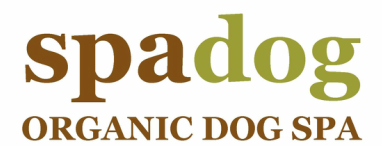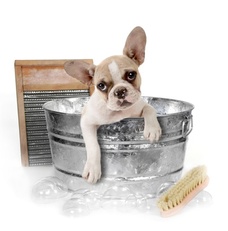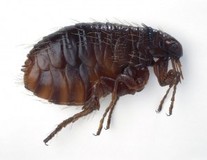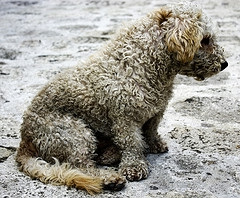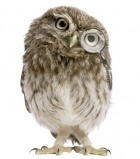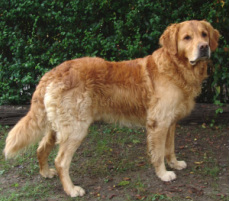
How do you know if your dog has a double coat?
Well, generally speaking, if your dogs hair stays the same length without it being cut, and it sheds, it's likely a double coat. It's called a double coat because it consists of two types of hair - an overcoat and an undercoat.
The overcoat is made up of guard hairs which are thicker, smoother, straighter hairs than the undercoat, which has a downy feel to it. The overcoat is water resistant, protects the skin from sun damage, twigs and thorns, and bugs. It acts as a temperature regulating layer between your dogs body and the (ambient) air, but needs proper air circulation to do so. The undercoat is your dogs insulation. She'll grow more of this in the winter, and shed it when the weather warms.
Different breeds of dogs have varying amounts of undercoat and overcoat, and because we've bred our dogs to have coats that wouldn't be found in nature, many dogs need help with the shedding process through brushing. As summer approaches, many people feel their dog is better off when their coat is shaved off, to help keep them cool. Except that, what happens to your dogs coat is this: as each hair has a predetermined length, and needs the weight of itself to fall out at the right time, cutting the hair makes it not fall out when it's supposed to, which can lead to clogged hair follicles, and skin issues. The proper temperature regulating system of the coat is altered, and it no longer performs it's intended functions; keeping your dog warm in winter, and cool in summer. You may also need to be concerned with sun burn, depending on how short the coat is shaved. As the coat grows back, it comes in with an overabundance of undercoat, and lack of overcoat, with a dull, fuzzy look to it. Additionally, this new coat acts more like a sponge, and less like a raincoat, and due to the softer texture, it becomes more prone to matting, requiring even more maintenance.
On some dogs, generally these are older, or have compromised immune systems - but not always - the coat does not grow back. This may happen in patches, or over the whole body. On most healthy dogs, the coat can be restored, but this may take one to two years of not cutting it, before it looks normal. Most people get caught in a cycle where the coat comes back looking unsightly, and their dog is hot again, so they keep shaving it off. In most cases, the dog is hot because she has an overabundance of undercoat which has not been brushed out.
Regular brushing of a double coated dog is essential to keeping her comfortable and healthy. Read our blog on “what brush should i use for my double coated dog?”, or visit a reputable groomer for their advise and a demonstration. The best way you can help your dog be comfortable, and keep her coat functioning properly, is to brush it on a regular schedule. A healthy coat will do the right thing for the weather, and your pet will be properly dressed for the seasons.
Well, generally speaking, if your dogs hair stays the same length without it being cut, and it sheds, it's likely a double coat. It's called a double coat because it consists of two types of hair - an overcoat and an undercoat.
The overcoat is made up of guard hairs which are thicker, smoother, straighter hairs than the undercoat, which has a downy feel to it. The overcoat is water resistant, protects the skin from sun damage, twigs and thorns, and bugs. It acts as a temperature regulating layer between your dogs body and the (ambient) air, but needs proper air circulation to do so. The undercoat is your dogs insulation. She'll grow more of this in the winter, and shed it when the weather warms.
Different breeds of dogs have varying amounts of undercoat and overcoat, and because we've bred our dogs to have coats that wouldn't be found in nature, many dogs need help with the shedding process through brushing. As summer approaches, many people feel their dog is better off when their coat is shaved off, to help keep them cool. Except that, what happens to your dogs coat is this: as each hair has a predetermined length, and needs the weight of itself to fall out at the right time, cutting the hair makes it not fall out when it's supposed to, which can lead to clogged hair follicles, and skin issues. The proper temperature regulating system of the coat is altered, and it no longer performs it's intended functions; keeping your dog warm in winter, and cool in summer. You may also need to be concerned with sun burn, depending on how short the coat is shaved. As the coat grows back, it comes in with an overabundance of undercoat, and lack of overcoat, with a dull, fuzzy look to it. Additionally, this new coat acts more like a sponge, and less like a raincoat, and due to the softer texture, it becomes more prone to matting, requiring even more maintenance.
On some dogs, generally these are older, or have compromised immune systems - but not always - the coat does not grow back. This may happen in patches, or over the whole body. On most healthy dogs, the coat can be restored, but this may take one to two years of not cutting it, before it looks normal. Most people get caught in a cycle where the coat comes back looking unsightly, and their dog is hot again, so they keep shaving it off. In most cases, the dog is hot because she has an overabundance of undercoat which has not been brushed out.
Regular brushing of a double coated dog is essential to keeping her comfortable and healthy. Read our blog on “what brush should i use for my double coated dog?”, or visit a reputable groomer for their advise and a demonstration. The best way you can help your dog be comfortable, and keep her coat functioning properly, is to brush it on a regular schedule. A healthy coat will do the right thing for the weather, and your pet will be properly dressed for the seasons.
